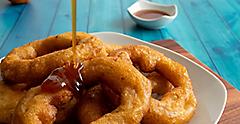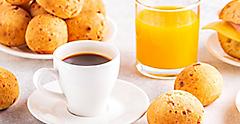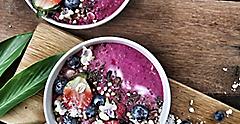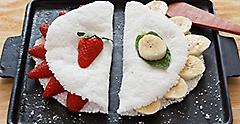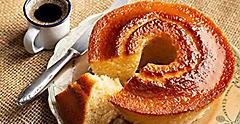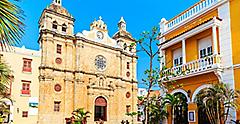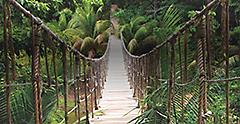Enjoy The Best Breakfast In South America
The Best Breakfast in the World Starts in South America
By Mary Luz Mejia | Published on July 20, 2023
Breakfast in South America tends to be a much more robust experience than in many other countries. While some cultures prefer to start the day with dainty donuts, cheese Danishes and a milky coffee, the best breakfast in places like Peru, Colombia and Brazil often starts with hot soups, freshly grilled corn cakes or portable meaty sandwiches. For people like me, who have savored one of these options, the best breakfast in the world is only a bite away!
The Most Important Meal Of The Day In Colombia
Breakfast in Colombia is taken seriously. There's a saying there my mom always told me that goes: Breakfast like a king, lunch like a prince, and dinner like a pauper. This just about sums up how Colombians feel about their caloric intake throughout the day. Depending on where you are in the country, breakfast is all about fortifying yourself for the day's activities.
In the hot coastal parts of the country, like Cartagena, locals can start the day with a deep-fried wonder called the arepa de huevo, a corn masa dough disc that is hand shaped, par-fried, opened on one end and filled with a raw hen's egg. The edges are sealed, and the egg-filled corn packet is fried to a golden brown. One bite of this and, much like I was, you'll be hooked on this crispy on the outside, runny or cooked egg yolk wonder.
In the Department of Antioquia, where I'm from, we start the day with a hot grilled white corn arepa, served with queso fresco (a mildly salty, fresh cheese), and perhaps a side of scrambled eggs with green onion and tomato (called huevos pericos) or a fried egg, sunny side up. There's always the ubiquitous cup of Colombian coffee nearby, or a big bowl of hot chocolate.
Speaking of hot chocolate, some people make a meal out of a big cup of hot chocolate called a chocolate completo (aka chocolate Santafereño), topped with a mild, white salty cheese also known as Queso Campesino. I know this sounds weird, but trust me, this sweet-salty sensation is fantastic. The cheese slightly melts in the hot chocolate, where you scoop it up with a spoon. You can also dip parva, or baked goods like yuca and corn flour rolls called almojabanas or pan de queso, into your drink to sop up every last drop.
If you're in Bogota or other cooler regions of the country, you might get served a changua, a traditional warm-me-up soup made of boiled water, milk, green onions, coriander, parsley and an egg that's poached in the liquid. You get a side of hot arepas or bread to dip as well. And while this is considered a hangover helper, people enjoy it even if there's no hair of the dog to chase.
In coffee-growing country, the calentado reigns supreme. This is a traditional plate consisting of last night's hearty leftovers, including rice, beans, plantain slices, steak, fried eggs and mini arepas. The idea is to eat a robust breakfast to tide you over while you work on the plantation. Today, many Colombians enjoy this on the weekend when they can take a leisurely approach without the rush of getting to work or school.
Hearty On-The-Go Breakfast In Peru
For those who like to start their breakfast in Peru with something a little sweeter, nothing beats Peruvian picarones. Created in Lima, these donut-like, deep-fried treats made with sweet potato or squash, flour, yeast and sugar are fluffy, crisp little bites of comfort. Go for the full effect if you really like yours sweet and add a drizzle of chancaca, a sugar cane syrup that's popular in Peru. These street food faves are available all over the city or in shops.
When I lived in Cuzco, high up in the Andean mountains, breakfast of choice was a warm cup of mate de coca (coca leaf tea that helps with altitude sickness and gives you a small boost of energy to start your day), and a just-steamed humita. Fresh-ground Peruvian corn (choclo) is used to make these tamale-looking creations. The fresh corn is layered into a corn husk with a slice of fresh cheese (which is my favorite variety) before getting steamed and served hot as is, or with a spicy salsa criolla made with onion, tomatoes, chili peppers, lime juice and herbs. It's said humitas were enjoyed by the Incas, and they continue to be a country-wide favorite. And because they take some time to prepare, locals often buy them from vendors and heat them up to serve at home for breakfast.
Experience Brazil's Tropical Twist
If the bakery visit is on the weekend, there's more time to enjoy breakfast, and the atmosphere is less down-the-coffee-and-go and more eat and relax with family. Those not enamored with coffee might opt for a vitamina, a popular breakfast smoothie made with avocado, milk and sugar. Or they'll start the day with a rainbow's worth of tropical fruits, including papaya, maracuya (passion fruit) or the Amazonian super fruit, açai, which are dark purple berries and often frozen before they're turned into cool açai bowls served with granola, sliced bananas or made into a smoothie.
One of the best breakfasts in the world, in my humble opinion, is the ridiculously delicious Brazilian cheese puff called a pao de queijo. Naturally gluten-free since they're made with tapioca starch, aka manioc starch, that's made by extracting the liquid from yucca or cassava, and fresh cheese, these savory, melt-in-your-mouth morsels are often served with slices of ham or cheese. Fair warning: You can't eat just one!
For those who like a sweet start to their day, there's also cake on the Brazilian breakfast menu. Yes, cake! These are tender crumbed, rich pound or coffee cakes that often bear the cultural imprint of European immigrants who brought these recipes over with them years ago. Usually baked in bundt or ring pans, these are uncomplicated cakes whose batter is often whipped up in a blender before being poured and baked. Favorites include orange pound cake, cuca de banana, a German-style banana coffee cake, Brazilian Bolo de Fubá (or cornmeal) cake and Portuguese-style sweet breads and cakes. Some would consider this the best breakfast in South America!
In the northeast of the country, Brazilians enjoy steamed cornmeal as their breakfast staple. Made using a special kind of cornmeal, locally called milharina, this is flaky textured and steamed in a pot that resembles a North African couscousière. Quick and easy to prepare, this dish is often served with butter, cheese, or both, for a satisfying start to any day.
If waking up to a South American breakfast in Lima, Rio or Cartagena appeals, you can visit all of these destinations on the Ultimate World Cruise. What a delicious way to start your day!
Get Royal Deals, Sign Up Today
Related Articles

Indonesian Food’s Global Influence | Royal Caribbean Cruises
READ MORE

[Infographic] Discover Famous Animals in Australia
READ MORE

The Best Cruise Restaurants Onboard Brilliance of the Seas | Royal Caribbean Cruises
READ MORE

The Best Cruise Restaurants Onboard Odyssey of the Seas | Royal Caribbean Cruises
READ MORE





